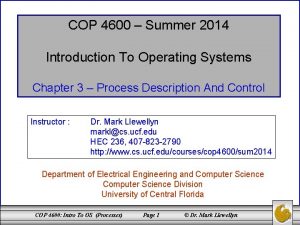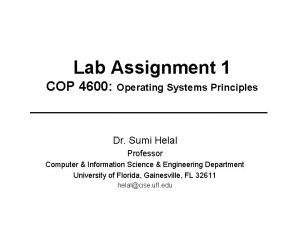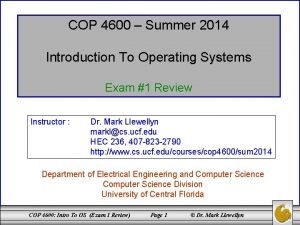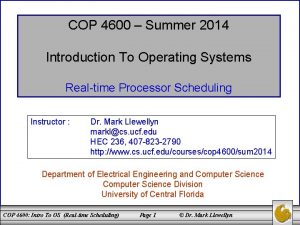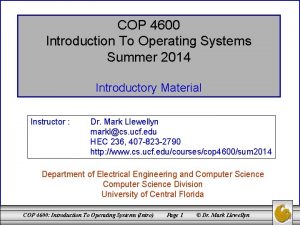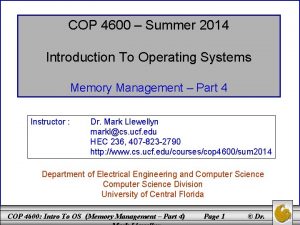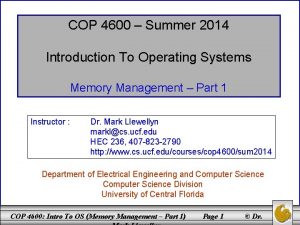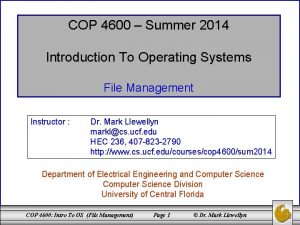COP 4600 Summer 2014 Introduction To Operating Systems









- Slides: 9

COP 4600 – Summer 2014 Introduction To Operating Systems Exam #1 Review Instructor : Dr. Mark Llewellyn markl@cs. ucf. edu HEC 236, 407 -823 -2790 http: //www. cs. ucf. edu/courses/cop 4600/sum 2014 Department of Electrical Engineering and Computer Science Division University of Central Florida COP 4600: Intro To OS (Exam 1 Review) Page 1 © Dr. Mark Llewellyn

Material Covered On Exam • Introductory Material. Overview of OS. • Overview of Processes. • Uni-processor Scheduling. • Multi-processor Scheduling. • Real-time Processor Scheduling. COP 4600: Intro To OS (Exam 1 Review) Page 2 © Dr. Mark Llewellyn

Format of the Exam • The exam consists of multiple choice and true/false questions plus some short answer/work problems. • There will be a couple of problems dealing with the uniprocessor scheduling protocols similar to those on the homework assignment, so be sure to know various protocols that we covered (concentrate on FCFS, Round-Robin, SPN, SRT, HRRN – ignore feedback techniques for this type of problem). • The remainder of the short answer problems deal with the various concepts we’ve covered in the notes. COP 4600: Intro To OS (Exam 1 Review) Page 3 © Dr. Mark Llewellyn

Sample Questions: 1. Which of the following scheduling policies cannot result in starvation? (circle all that apply) a. b. c. d. e. 2. FIFO LIFO SJN Priority Round Robin Which of the following result in the same process ordering when drawn on a Gant chart? (circle all that apply) a. b. c. d. e. FIFO LIFO SJN (assume all jobs have the same CPU burst times and history) Priority (assume all jobs have same priority) Round Robin (assume the time quantum is less than the longest burst time) COP 4600: Intro To OS (Exam 1 Review) Page 4 © Dr. Mark Llewellyn

Sample Questions: 3. For the processes shown below, develop a Gantt chart and determine the average waiting time for a process under the FCFS scheduling protocol. 4. Every interrupt can be disabled. True False COP 4600: Intro To OS (Exam 1 Review) Page 5 © Dr. Mark Llewellyn

Sample Questions: 5. The uniprocessor scheduling protocol HRRN is preemptive. TRUE FALSE 6. The uniprocessor scheduling protocol SPN tends to penalize long processes by potentially increasing their waiting time. TRUE FALSE 7. It is possible for a process to move from the blocked/suspend state immediately to the ready state. TRUE FALSE COP 4600: Intro To OS (Exam 1 Review) Page 6 © Dr. Mark Llewellyn

Sample Questions: ANSWERS 1. Which of the following scheduling policies cannot result in starvation? (circle all that apply) a. b. c. d. e. 2. FIFO LIFO SJN Priority Round Robin Which of the following result in the same process ordering when drawn on a Gant chart? (circle all that apply) a. b. c. d. e. FIFO LIFO SJN (assume all jobs have the same CPU burst times and history) Priority (assume all jobs have same priority) Round Robin (assume the time quantum is less than the longest burst time) COP 4600: Intro To OS (Exam 1 Review) Page 7 © Dr. Mark Llewellyn

Sample Questions: ANSWERS 3. For the processes shown below, develop a Gantt chart and determine the average waiting time for a process under the FCFS scheduling protocol. 8 4 11 3 6 A 0 B 8 C 12 D 23 E 26 Waiting times: A = 0, B = 6, C = 8, D = 17, E = 18 Average waiting time = (0 + 6 + 8 + 17 + 18)/5 = 49/5 = 9. 8 4. Every interrupt can be disabled. True False COP 4600: Intro To OS (Exam 1 Review) Page 8 32 © Dr. Mark Llewellyn

Sample Questions: 5. The uniprocessor scheduling protocol HRRN is preemptive. TRUE FALSE 6. The uniprocessor scheduling protocol SPN tends to penalize long processes by potentially increasing their waiting time. TRUE FALSE 7. It is possible for a process to move from the blocked/suspend state immediately to the ready state. TRUE FALSE COP 4600: Intro To OS (Exam 1 Review) Page 9 © Dr. Mark Llewellyn
